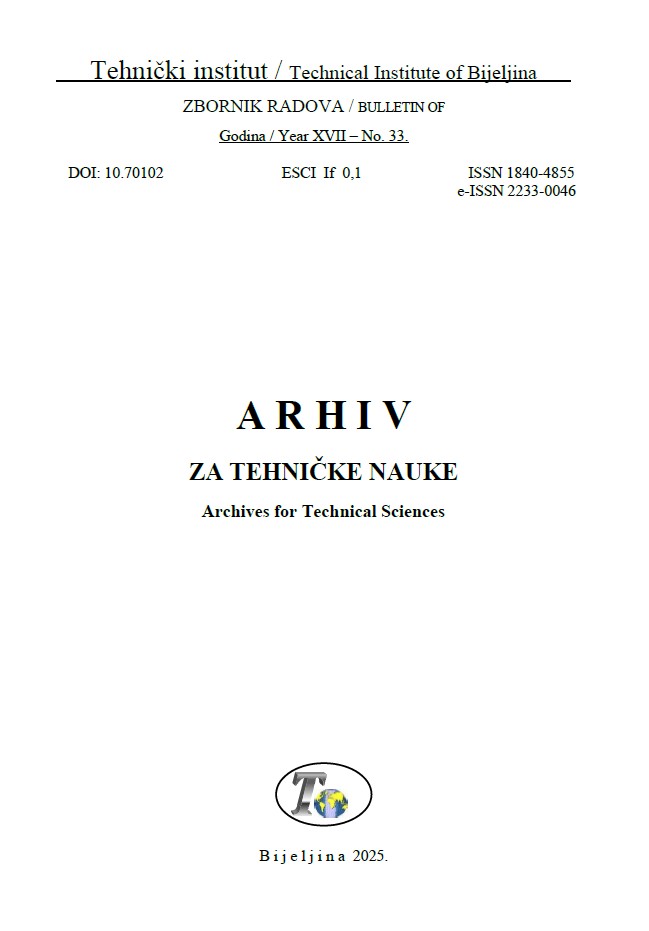AEGIS FLARE: IOT-ENABLED ROBOTIC FIREFIGHTER FOR ADVANCED FIRE DETECTION AND SUPPRESSION
Modern techniques for identification and evacuation of fires are required because they represent a serious risk to human life, belongings, including the surroundings. In order to tackle this scenario, this research project presents Aegis Flare, IoT based autonomous rescuer. Aegis Flare uses OpenCV analyzing images to automatically identify fla...
By E. Veera Boopathy, M. Ishwarya Niranjana, S. Nethaji Naveen Prasath, P. Sivabalvigneshan, R. Sanjesh, S. Sanjay, A. Nithishkumar, S. Vishal
THE HISTORICAL SIGNIFICANCE OF MUD ARCHITECTURE IN ARID REGIONS FOR SUSTAINABILITY AND DURABILITY
Mud architecture has played a crucial role in shaping human settlements in arid regions, offering sustainable and durable solutions for centuries. This study explores the historical evolution of mud architecture, highlighting its adaptability to extreme climatic conditions and its significance in preserving cultural heritage. The paper examines tra...
By Abdurahim Mannonov, Khurshid Samatov, Nilufar Fayzieva, Valisher Sapayev, Dadaxon Abdullayev, Nargiza Ruzmetova, Khafiza Khasanova
INTELLIGENT ROBOTIC SYSTEM FOR EFFICIENT SOLAR PANEL MONITORING
In this paper, we will introduce a new concept of improving the efficiency of solar panels and the ease of their maintenance by applying relevant robotics and a mobile application concept. This component relies on various sensors, such as rain sensors, dust sensors, and real time clocks (RTCs), to enhance thorough cleaning and maintenance. The robo...
By E. Veera Boopathy, S. Samraj Samraj, S. Vishnushree, L. Vigneash, I. Sheik Arafat, L.S. Karthick
THE INFLUENCE OF ISLAMIC ARCHITECTURE ON EUROPEAN DESIGN
Islamic architecture's impact on European design is a manifestation of centuries of cultural interaction, commerce, and conquest. Islamic architectural forms, including domes, arches, geometric patterns, and calligraphy, were introduced into European forms through contact in Spain, Sicily, and the Crusades. This research examines how Islamic archit...
By Nodir Karimov, Maqsad Maytakubov, Janjayxan Darmenov, Habibakhon Mamadalieva, Farrux Akchayev, Ilhom Karimov, Gullola Kurbanova
GEOCHEMICAL AND GEOLOGICAL STUDIES OF OIL SHALES IN AB KASEH SECTION, KOUHRANG COUNTY, CHAHARMAHAL AND BAKHTIARI PROVINCE, IRAN
This study investigates the geochemistry of oil shales from the Ab Kaseh section in western Kohrang, Chaharmahal and Bakhtiari Province, Iran. Ten shale samples were collected for geochemical analyses, including Rock-Eval pyrolysis and XRF/ICP analyses. Ten thin sections were also prepared for petrographic analysis. A stratigraphic column and depos...
By Milad Tahmasebi, Farhad Ehya, Ghodratollah Rostami Paydar
LOW-COST REMOTELY-OPERATED VEHICLE NAVIGATION WITH GPS AND RF LORA INTEGRATION
In recent decades, remote-controlled vehicles (ROVs) have attracted significant attention because of their potential applications in healthcare, medicine, agriculture, and civilian information. In this article, we investigate the development of low-cost mobile robots equipped with a global positioning system (GPS). GPS-assisted robot is used to pro...
By Huu Khoa Tran, Viet Thang Le, Thanh Trang Tran, Van Dung Nguyen
THE ARCHITECTURAL LEGACY OF SAMARKAND AND BUKHARA ALONG THE SILK ROAD
Samarkand and Bukhara, two of the most historically important cities on the Silk Road, have been renowned for centuries for their architectural charm and cultural legacy. This article discusses their architectural development, analyzing how Persian, Turkic, and Islamic traditions influenced their cityscapes. The article emphasizes the application o...
By Ollabergan Allaberganov, Nargiza Mirtalipova, Gulnozakhon Ganieva, Guli Isayeva, Shamsikamar Abatova, Nodira Nurullayeva, Dilfuzakhon Kozokboeva, Mavzuna Mukhiddinova
THE ROLE OF DIGITAL TECHNOLOGY IN ARCHIVING ETHNO-TOURISTIC LANDMARKS
Ethno-touristic sites must be conserved to preserve the cultural heritage and historical identity of the people. Documenting these sites is easier with enhanced digital technology, which provides faster and new ways of documenting, conserving, and managing tourism. Digital technology such as 3D scanning, virtual reality (VR), augmented reality (AR)...
By Khayrinisa Yunuskhodjaeva, Umida Almatova, Nodir Karimov, Surayyo Khaydarova, Shakhnoza Jalolova, Akramov Bahodir, Ibragimjan Toshmatov
ANALYSIS OF SAMARKAND’S REGISTAN SQUARE AS A MASTERPIECE OF ISLAMIC ARCHITECTURE
Samarkand's Registan Square is among the greatest Islamic architectural achievements, symbolizing the architectural and cultural victory of the Timurid dynasty. The Registan Square, being the architectural and cultural hub of Samarkand, consists of three colossal madrasahs of Ulugh Beg, Sher-Dor, and Tilya-Kori symbolizing the splendor of beauty an...
By Nodira Nurullayeva, Dadaxon Abdullayev, Dilnoza Kulboyeva, Abdurahim Mannonov, Gulbahor Eshbekova, Kamola Fuzailova, Odiljon Boynazarov
EVALUATING THE SEISMIC RESPONSE OF REINFORCED CONCRETE BUILDINGS WITH SHEAR WALLS ON VARIED SLOPING TERRAINS USING PUSHOVER ANALYSIS
This study investigates the seismic performance of a four-story reinforced concrete frame building with irregularities, situated on sloping ground. Recognizing the increasing prevalence of construction on slopes due to population growth and urban expansion, this research employs a step-back model on the sloping terrain at inclinations of 0°, 10...
By Tushar Golait, Neeraj Tiwari, Manjeet Singh Hora






